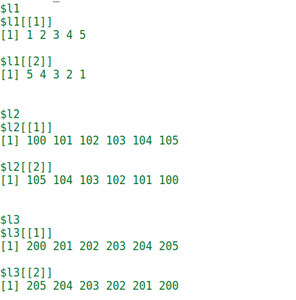Convert Nested Lists to Dataframe in R
Last Updated :
15 Nov, 2021
In this article, we will discuss how to Convert Nested Lists to Dataframe in R Programming Language.
It can be done with two methods:
- Convert Nested lists to Data Frame by Column.
- Convert Nested lists to Data Frame by Row.
First, let’s Create a nested list.
Code block
Output:

fig 1: Nested List
Method 1: To convert nested list to Data Frame by column.
Approach:
- Create dataframe using data.frame function with the do.call and cbind.
- cbind is used to bind the lists together by column into data frame.
- do.call is used to bind the cbind and the nested list together as a single argument in the Data frame function.
- Also, store the whole data frame in a variable named data_frame and print the variable.
Code:
R
nested_list <- list(l1 = list(1:5, 5:1 ),
l2 = list(100:105, 105:100 ),
l3 = list(200:205, 205:200 ))
data_frame <- as.data.frame(do.call(cbind, nested_list))
data_frame
|
Output:
l1 l2 l3
1 1, 2, 3, 4, 5 100, 101, 102, 103, 104, 105 200, 201, 202, 203, 204, 205
2 5, 4, 3, 2, 1 105, 104, 103, 102, 101, 100 205, 204, 203, 202, 201, 200
Method 2: To convert nested list to Data Frame by row.
Approach:
- Create dataframe using data.frame function with the do.call and rbind.
- rbind is used to bind the lists together by row into data frame.
- do.call is used to bind the rbind and the nested list together as a single argument in the Data frame function.
- Also, store the whole data frame in a variable named data_frame and print the variable.
Code:
R
nested_list <- list(l1 = list(1:5, 5:1 ),
l2 = list(100:105, 105:100 ),
l3 = list(200:205, 205:200 ))
nested_list
data_frame <- as.data.frame(do.call(rbind, nested_list))
data_frame
|
Output:
V1 V2
l1 1, 2, 3, 4, 5 5, 4, 3, 2, 1
l2 100, 101, 102, 103, 104, 105 105, 104, 103, 102, 101, 100
l3 200, 201, 202, 203, 204, 205 205, 204, 203, 202, 201, 200
Share your thoughts in the comments
Please Login to comment...